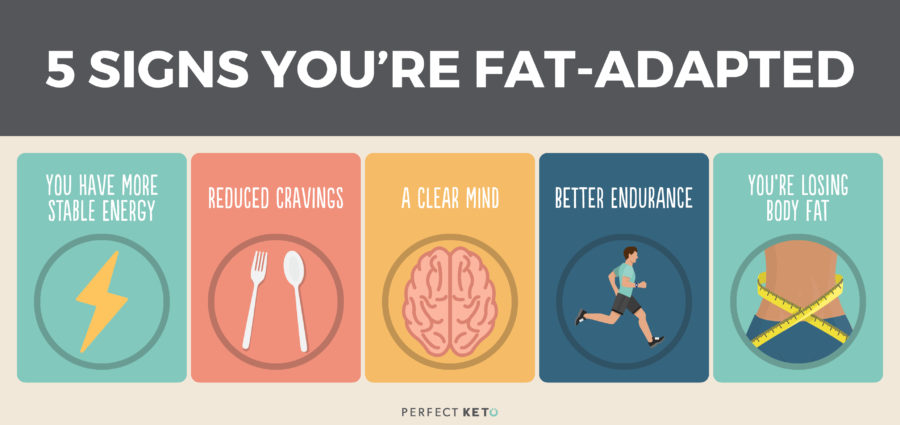Visit any keto-friendly source and you’ll come across the term “fat-adapted.” The idea is that when you eat low-carb long enough, you’ll start burning fat (rather than sugar) for energy.
The description, however, often ends here. Nobody says what fat-adaptation actually is, much less how to tell if you’re in this fat-burning metabolic state.
The good news is that you don’t need a ketone meter, blood test, or urine sample to tell if you’re fat-adapted. There are clues, both mental and physical, that signal your level of fat-adaptation.
This article will cover how to know whether you’re fat-adapted, as well as the difference between being fat-adapted and simply being in ketosis.
What is Fat-Adaptation?
Fat adaptation is your body’s ability to burn fat as its main fuel source. When you’re fat-adapted, you turn fat into adenosine triphosphate (ATP), the energetic currency that powers nearly every cell in your body.
Early humans were fat-adapted. When they ran out of mammoth meat, they didn’t get tired, cranky, or lethargic. Instead, they tapped into a vast reserve of stored energy: body fat.
Fat adaptation helped them survive.
Even a skinny caveman had plenty of fat stores packed on for a foodless day. A 170-pound hunter-gatherer with 10% body fat, for instance, had 17 pounds of fat mass waiting to be burned.
Fat is your body’s best way to save energy. It’s compact (especially compared to sugar storage) and it’s easy to put on, as most of us know all too well. It also burns hot, producing a lot of energy as you work through it.
Unfortunately, a modern, high-carb Western diet does not promote fat-adaptation. Instead, it promotes fat storage.
Here’s the step-by-step process of how that happens:
-
- High-carb, Western-style diets chronically elevate blood sugar (blood glucose)[*]
-
- High blood sugar levels raise insulin levels
-
- High insulin levels promote fat storage (and prevent fat oxidation)[*]
- Western diets typically contain excess calories as well, meaning stored fat never has a chance to burn off
And fat storage isn’t the only downside of a glucose-happy modern diet. Compared to fat, glucose is also a shorter-term, more inflammatory, and less potent fuel source[*].
Fortunately, you don’t need to fast like your mammoth-hunting ancestors become fat-adapted. Eating high-fat and low-carb will do the trick. In other words, eating the ketogenic diet.
There is, however, a distinction between fat adaptation and being in ketosis.
Fat Adaptation Vs. Being in Ketosis
The average person may enter a mild state of ketosis during an overnight fast. Fasting causes your blood sugar and insulin levels to drop. These metabolic changes signal your liver to turn fatty acids into ketones[*].
Specifically, your liver cells burn fatty acids derived from saturated fats, monounsaturated fats, and polyunsaturated fats. This process produces ketone bodies, which you then break down into acetyl-CoA, and then into ATP (cellular energy)[*].
The above process produces ketones, and it can happen during a simple fast. But you can also convert fatty acids directly to acetyl-CoA to fuel your energy needs[*].
When this happens on a regular basis, you’re fat-adapted. Your body has fully shifted over to burning fat as its primary fuel source, to the point where you have metabolic flexibility: you can eat carbs and fall out of ketosis, and your body will snap right back into keto once it processes the carbs.
Getting into ketosis — even on the keto diet — does not guarantee fat-adaptation. You’ll start making ketones in the first week of keto.
The fat adaptation process, however, may take a month or more. That’s why it’s important to stick to strict keto for at least a few weeks when you’re just starting out if you want all the biggest benefits of ketosis.
Track Your Ketosis

Perfect Keto Ketone Test Strips – Accurate, Fast, Easy-to-Use. Monitor Your Keto Progress.
5 Signs You’re Fat-Adapted

Since fat-adaptation is distinct from simple ketosis, you can’t measure fat adaptation by testing ketones. Test strips and blood samples aren’t useful for figuring out if you’re fat-adapted.
Instead, your best bet is to rely on subjective measures like how you feel. Here are five ways to know if you’re fat-adapted:
#1 You Have More Stable Energy
When you eat carbs — particularly simple carbs like sugar — you often have swings in energy (“sugar highs” and “sugar crashes”). The same happens when you’re transitioning into fat adaptation because your body is still looking for carbs as a fuel source instead of fat.
But when you lower your carb intake and become fat-adapted, you have plenty of body fat to burn at all times.
Ketones also suppress hunger, which means you can skip breakfast or lunch, no problem. This is called intermittent fasting, and it’s easy when you’re fat-adapted.
If they have to, humans can go for weeks running on nothing but fat stores and stay surprisingly energetic. This is somewhat extreme, and not necessarily recommended, but it shows how powerful fat adaptation can be.
Bottom line: If you go from energy swings to feeling stable energy throughout the day, you’re probably fat-adapted.
#2 Reduced Cravings
Of all the macronutrients, fat is the most satiating. There are several reasons for this[*]:
-
- Fat contains 9 calories per gram, while carbs and protein contain 4 calories per gram
-
- Fat lowers circulating ghrelin, your hunger hormone
-
- Fat lowers neuropeptide Y, another hunger-stimulator
- Fat boosts CCK, a neuropeptide associated with feeling full
The net effect of all these changes is that a high-fat, low-carb diet reduces hunger and cravings[*].
Hunger suppression and reduced cravings are two of the major reasons that high-fat diets like keto are so effective for weight loss. When you’re fat-adapted, your sugar cravings effectively disappear.
It’s worth noting that in the beginning stages of fat adaptation it’s possible you’ll experience carb cravings.
Sugar is physically addictive, and you’ll likely have withdrawals and cravings for a few days once you cut it out of your diet[*]. But as soon as you’re fat-adapted, the cravings will subside.
Bottom line: When your cravings disappear, it’s a good sign that you’re in full-on fat-burning mode.
#3 A Clear Mind
When you decide to drop carbs, you may experience a temporary dip in energy and brain function. These symptoms are a sign of the keto flu. You can expect headaches and brain fog, too — most likely due to carb withdrawal.
Once the initial phase of fat-adaptation is over, keto flu will subside, and the real health benefits of ketosis will kick in.
Ketones make excellent brain fuel. They’ve been shown, in fact, to enhance memory, attention, and task switching performance in the elderly[*].
Glucose, however, has not fared so well in the lab. In one study, participants given a glucose drink performed significantly worse than placebo-fed controls on a series of cognitive tests[*]. In other words, excess glucose slows your brain down.
Bottom line: If you feel a sudden increase in mental clarity after a couple of weeks on a keto diet, odds are you’re fat-adapted.
#4 Better Endurance
In 1980, athletic researcher Steve Phinney and his colleagues showed — to the surprise of many — that fat adaptation boosts physical endurance capacity[*].
The design was simple. Untrained, overweight people did two weeks of baseline (high-carb) dieting, followed by six weeks of calorie-restricted (ketogenic) dieting. Phinney and his colleagues measured endurance performance and fat oxidation before and after the shift in diet.
Participants burned more fat and stayed on the treadmill longer in their keto-adapted state than they did in their baseline, high-carb state.
When fat is your primary fuel source for exercise, you spare glycogen (stored glucose) for longer. That glycogen comes in handy later, when you need extra fuel at the end of long or high-intensity workouts.
Bottom line: Increased endurance is a good sign that you’re becoming fat-adapted.
#5 You’re Losing Body Fat
The induction phase of low-carb dieting can be thrilling. Often, several pounds fly off within the first week.
The initial weight loss on keto is usually water weight, though — the result of rapidly emptying glycogen stores[*]. Glycogen (stored sugar) is mostly water.
Real, sustained weight loss — fat loss, that is — kicks in after about four weeks of pretty strict keto dieting.
Once you’re fat-adapted, your metabolism favors burning adipose tissue (body fat) for fuel whenever it needs energy — provided you aren’t overeating, which is hard to do on a keto diet because it’s so satiating.
Bottom line: If you’re losing weight after about a month of a low-carb dieting, you’re probably fat-adapted.
The Takeaway: How To Know if You’re Fat-Adapted
Fat-adaptation is part of the ketogenic journey, but it’s not the same as ketosis.
Ketosis is the production of ketones. That can happen overnight.
But with a month or so of low-carb eating, your cells start to shift over to burning fat more permanently.
To tell if you’re fat-adapted: check your energy levels, cravings, focus, endurance performance, and body fat. If they’re all improving, good news: you’re burning fat full-time.
